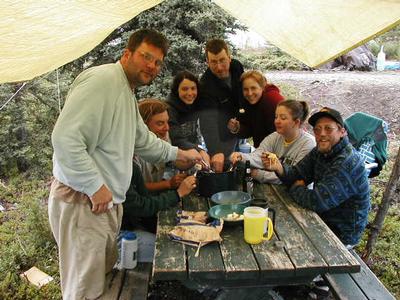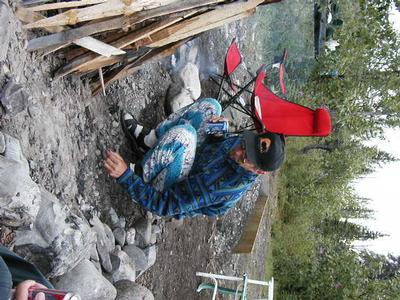
|
21 July, 2001Picking projects and studying geophysics 4:05 p.m. The weather was rainy and cool again today for most of the day, so once again our data collection was postponed. This is real-life science; weather and other variables affect our schedule and our ability to collect data. It is said that necessity is the mother of invention; perhaps a reader will suggest a design for water-proof geophysical tools, allowing us clear this hurdle (assuming the weather forecast for more rain is accurate). It should be noted that collecting data when it is raining and 50 degrees F is a cold way to spend the day so funding to make and market the waterproof seismic gear may be hard to come by. Life on the ice ... almost Because we were in camp for most of the day, I worked on updating my journals, working out a few imaginary bugs and preparing an abstract, or summary of results for presentation at the Geological Society of America's fall conference. Of course, in this case, I will have to write about the likely results, as we won't know the results of our experiment until we finish collecting the data. Kendra also spent the morning working on her abstract to present at the same meeting. The REU students were given time today (slightly ahead of schedule) to begin planning the details of their research project; the possibilities are nearly limitless. The hardest part of an experiment is often thinking of a specific question to test and the methods you will use to test the idea. Some of the ideas that were tossed around included ablation studies (how fast glacier ice melts in various conditions), hydrological studies (measuring the drainage pattern of the glacier as water sinks through a crevasse or moulin and comes out at vents in the bottom down glacier), sedimentology studies (looking at the types of rocks in the outwash plain and making inferences about (a) how the rocks got there, (b) the types of rocks up-glacier.), etc. REU students will brainstorm ideas over the next couple of days before preparing a proposal for their projects. This afternoon, with potential projects in their heads, they left camp to scout around for likely research sites. *** I am writing early this evening because I am in charge of dinner tonight and expect that my energy will run out quickly afterwards; my sleeping bag has been calling to me all day. Quick note about food: when I first wrote (July 15), I expected to be cooking alone. I don't. For example, last night Nelson prepared spaghetti; this morning, Mehgan and Jeff prepared French toast... we are eating together and eating well. The chef and dishwashing responsibilities rotate among members of our camp, keeping everyone involved and everyone satisified. Menus are also communal, accommodating the dietary needs of vegetarians and meat-eaters. Since I lobbied hard for cheese fondue, the pressure to prepare a good meal is high. Luckily, the saying that "hunger makes the best sauce" is as true in the field as it is at home. Science at work A couple of nights ago (July 19), Greg gave an after-dinner talk as we sat around the campfire. As we unwound from the work day, Greg shared with the group the reasons he ended up as a geophysist and a teacher, and related some of the challenges and rewards of his profession. It is a story about one path to becoming a scientist. As a boy, Greg enjoyed building and playing with models, fiddling with and writing computer programs, and playing outside. At first, he thought engineering might match his interests most closely. He realized, after only a short while in college, that geology was a much better fit and geophysics was closer still; Greg's days are spent ... (1) going exotic places to play outside... Besides Alaska, he has been to Mt. Ranier (a volcano in Washington), Wyoming, New Mexico and Utah this summer (2) fiddling with computer programs... Part of Greg's professional work is to search for ways to improve the methods geophysists use to image the subsurface (underground) (3) sharing that information with others in the classroom and at field camps and conferences. Geologists use several methods to "see" what is underneath the Earth. For large-scale and deep structures, scientists use a variety of methods to make inferences about the Earth: a) earthquakes and how they seismic waves are felt at places around the world; b) sensitive changes in gravity from place to place (more massive places have more gravity... Thus, it is possible to lose a few ounces just by traveling from a high-density area to an area with low density); c) active-source seismology (a large-scale version of what we are doing on the glacier), using explosives or giant trucks equipped with flat steel plates that slam into the ground This type of deep geophysics is parcticularly useful for finding natural resources, e.g., oil, gas, minerals, etc. As you may imagine, many companies are interested in the results of deep geophysics and spend billions of dollars on deep geophysical research in order to make a profit on finding and selling those resources. In contrast, shallow geophysics is useful for mapping the path of groundwater (useful for preventing or cleaning up pollution), testing the stability of an area before building a structure, etc. As you may also imagine, many companies are NOT as interested in getting as good shallow geophysical data. Some dishonest or struggling companies do not want to know the extent of pollution they may be causing because, in most cases, they will have to pay to clean it up. Sadly, this also real-life science. Part of Greg's mission is to teach as many people as he can to recognize and expose the signs of "bad" geophysical science. Knowledge is power so... knowledge to the people. Cheers. ~SM
Contact the TEA in the field at . If you cannot connect through your browser, copy the TEA's e-mail address in the "To:" line of your favorite e-mail package. |






